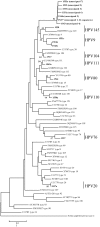Mucosal and cutaneous human papillomaviruses detected in raw sewages
- PMID: 23341898
- PMCID: PMC3544852
- DOI: 10.1371/journal.pone.0052391
Mucosal and cutaneous human papillomaviruses detected in raw sewages
Abstract
Epitheliotropic viruses can find their way into sewage. The aim of the present study was to investigate the occurrence, distribution, and genetic diversity of Human Papillomaviruses (HPVs) in urban wastewaters. Sewage samples were collected from treatment plants distributed throughout Italy. The DNA extracted from these samples was analyzed by PCR using five PV-specific sets of primers targeting the L1 (GP5/GP6, MY09/MY11, FAP59/64, SKF/SKR) and E1 regions (PM-A/PM-B), according to the protocols previously validated for the detection of mucosal and cutaneous HPV genotypes. PCR products underwent sequencing analysis and the sequences were aligned to reference genomes from the Papillomavirus Episteme database. Phylogenetic analysis was then performed to assess the genetic relationships among the different sequences and between the sequences of the samples and those of the prototype strains. A broad spectrum of sequences related to mucosal and cutaneous HPV types was detected in 81% of the sewage samples analyzed. Surprisingly, sequences related to the anogenital HPV6 and 11 were detected in 19% of the samples, and sequences related to the "high risk" oncogenic HPV16 were identified in two samples. Sequences related to HPV9, HPV20, HPV25, HPV76, HPV80, HPV104, HPV110, HPV111, HPV120 and HPV145 beta Papillomaviruses were detected in 76% of the samples. In addition, similarity searches and phylogenetic analysis of some sequences suggest that they could belong to putative new genotypes of the beta genus. In this study, for the first time, the presence of HPV viruses strongly related to human cancer is reported in sewage samples. Our data increases the knowledge of HPV genomic diversity and suggests that virological analysis of urban sewage can provide key information useful in supporting epidemiological studies.
Conflict of interest statement
Figures


Similar articles
-
A large spectrum of alpha and beta papillomaviruses are detected in human stool samples.J Gen Virol. 2015 Mar;96(Pt 3):607-613. doi: 10.1099/vir.0.071787-0. Epub 2014 Nov 14. J Gen Virol. 2015. PMID: 25398789
-
A teat papillomatosis case in a Damascus goat (Shami goat) in Hatay province, Turkey: a new putative papillomavirus?Arch Virol. 2018 Jun;163(6):1635-1642. doi: 10.1007/s00705-018-3781-2. Epub 2018 Mar 3. Arch Virol. 2018. PMID: 29502149
-
Human papillomaviruses of the mucosal type are present in some cases of extragenital Bowen's disease.Br J Dermatol. 2005 Jun;152(6):1243-7. doi: 10.1111/j.1365-2133.2005.06643.x. Br J Dermatol. 2005. PMID: 15948988
-
Oncogenic Papillomavirus and Polyomavirus in Water Environments: Is There a Potential for Waterborne Transmission?Food Environ Virol. 2014 Mar;6(1):1-12. doi: 10.1007/s12560-013-9134-0. Epub 2013 Nov 30. Food Environ Virol. 2014. PMID: 24293168 Review.
-
Molecular methods for identification and characterization of novel papillomaviruses.Clin Microbiol Infect. 2015 Sep;21(9):808-16. doi: 10.1016/j.cmi.2015.05.011. Epub 2015 May 21. Clin Microbiol Infect. 2015. PMID: 26003284 Review.
Cited by
-
UVC Inactivation of dsDNA and ssRNA Viruses in Water: UV Fluences and a qPCR-Based Approach to Evaluate Decay on Viral Infectivity.Food Environ Virol. 2014 Dec;6(4):260-8. doi: 10.1007/s12560-014-9157-1. Epub 2014 Jun 22. Food Environ Virol. 2014. PMID: 24952878
-
Differential removal of human pathogenic viruses from sewage by conventional and ozone treatments.Int J Hyg Environ Health. 2018 Apr;221(3):479-488. doi: 10.1016/j.ijheh.2018.01.012. Epub 2018 Feb 1. Int J Hyg Environ Health. 2018. PMID: 29402695 Free PMC article.
-
Extension of the viral ecology in humans using viral profile hidden Markov models.PLoS One. 2018 Jan 19;13(1):e0190938. doi: 10.1371/journal.pone.0190938. eCollection 2018. PLoS One. 2018. PMID: 29351302 Free PMC article.
-
A State-of-the-Art Scoping Review on SARS-CoV-2 in Sewage Focusing on the Potential of Wastewater Surveillance for the Monitoring of the COVID-19 Pandemic.Food Environ Virol. 2022 Dec;14(4):315-354. doi: 10.1007/s12560-021-09498-6. Epub 2021 Nov 2. Food Environ Virol. 2022. PMID: 34727334 Free PMC article.
-
Identification of circulating human papillomavirus types through high-throughput sequencing of Canadian municipal and institutional wastewater samples.Appl Environ Microbiol. 2025 Jul 23;91(7):e0034825. doi: 10.1128/aem.00348-25. Epub 2025 Jun 5. Appl Environ Microbiol. 2025. PMID: 40470962 Free PMC article.
References
-
- Ferlay J, Shin HR, Bray F, Forman D, Mathers C, et al. (2010) GLOBOCAN 2008 v1.2, Cancer Incidence and Mortality Worldwide: IARC CancerBase No. 10.
-
- Syrjanen S (2010) The role of human papillomavirus infection in head and neck cancers. Ann Oncol 21 7: vii243–vii245. - PubMed
Publication types
MeSH terms
Substances
Associated data
- Actions
LinkOut - more resources
Full Text Sources
Other Literature Sources
Miscellaneous

